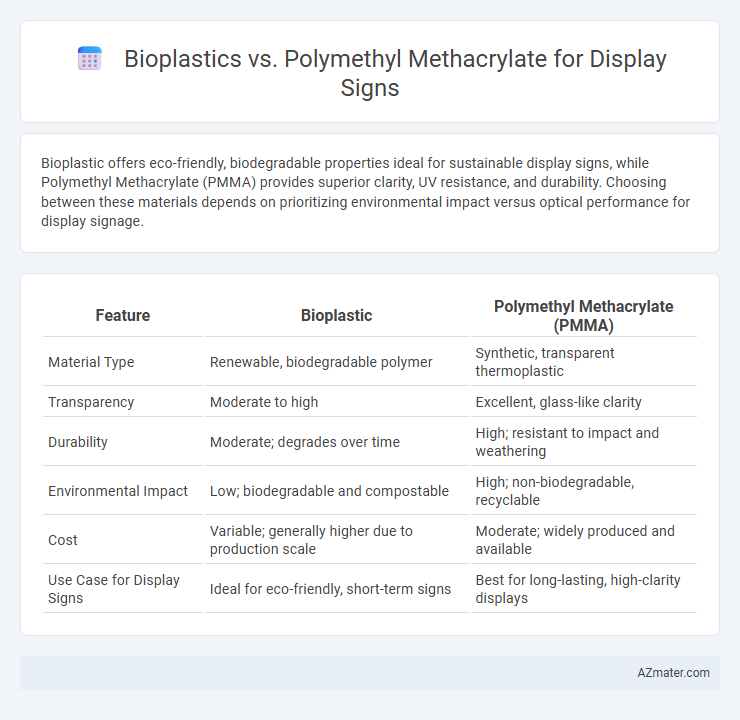Bioplastic offers eco-friendly, biodegradable properties ideal for sustainable display signs, while Polymethyl Methacrylate (PMMA) provides superior clarity, UV resistance, and durability. Choosing between these materials depends on prioritizing environmental impact versus optical performance for display signage.
Table of Comparison
| Feature | Bioplastic | Polymethyl Methacrylate (PMMA) |
|---|---|---|
| Material Type | Renewable, biodegradable polymer | Synthetic, transparent thermoplastic |
| Transparency | Moderate to high | Excellent, glass-like clarity |
| Durability | Moderate; degrades over time | High; resistant to impact and weathering |
| Environmental Impact | Low; biodegradable and compostable | High; non-biodegradable, recyclable |
| Cost | Variable; generally higher due to production scale | Moderate; widely produced and available |
| Use Case for Display Signs | Ideal for eco-friendly, short-term signs | Best for long-lasting, high-clarity displays |
Introduction to Display Sign Materials
Bioplastic and polymethyl methacrylate (PMMA) are prominent materials in display sign manufacturing, each offering distinct advantages. Bioplastics provide eco-friendly, biodegradable alternatives with renewable resource bases, catering to sustainability demands. PMMA, known for its superior clarity, durability, and weather resistance, remains a preferred choice for high-quality, long-lasting display signs.
Overview of Bioplastics
Bioplastics are derived from renewable biomass sources such as corn starch, sugarcane, or cellulose, offering a sustainable alternative to traditional petroleum-based plastics like polymethyl methacrylate (PMMA). These materials exhibit biodegradability or enhanced recyclability, reducing environmental impact during disposal compared to non-biodegradable PMMA. Bioplastics for display signs provide comparable clarity and durability while supporting eco-friendly initiatives in advertising and retail environments.
Fundamentals of Polymethyl Methacrylate (PMMA)
Polymethyl Methacrylate (PMMA) is a transparent thermoplastic known for its excellent optical clarity, UV resistance, and weatherability, making it ideal for display signs requiring durability and high visibility. Unlike bioplastics, PMMA offers superior rigidity and resistance to impact, ensuring long-lasting performance in outdoor environments. Its chemical structure provides a stable and lightweight alternative to glass, commonly used in high-quality signage applications.
Sustainability and Environmental Impact
Bioplastic derived from renewable resources offers significant sustainability benefits over polymethyl methacrylate (PMMA), which is petroleum-based and non-biodegradable. Bioplastics reduce carbon footprint and generate less toxic waste during production and disposal, while PMMA persists in landfills for decades, contributing to plastic pollution. Choosing bioplastic for display signs supports circular economy goals by enabling compostability or recyclability and minimizing environmental impact throughout the product lifecycle.
Mechanical and Physical Properties Comparison
Bioplastic exhibits greater flexibility and biodegradability compared to Polymethyl Methacrylate (PMMA), which offers superior hardness and scratch resistance ideal for durable display signs. PMMA's higher tensile strength and UV resistance ensure long-term clarity and performance in outdoor environments. Bioplastic, while environmentally friendly, typically demonstrates lower impact resistance and decreased weather stability relative to PMMA.
Durability and Weather Resistance
Bioplastics offer moderate durability and weather resistance, making them suitable for short-term or temporary display signs but may degrade under prolonged UV exposure and harsh weather conditions. Polymethyl Methacrylate (PMMA), commonly known as acrylic, exhibits superior durability with excellent UV resistance, clarity retention, and impact resistance, ensuring long-lasting performance in outdoor display signage. For applications requiring robust weather resistance and structural integrity, PMMA is the preferred material over most bioplastics.
Visual Clarity and Aesthetics
Bioplastic and Polymethyl Methacrylate (PMMA) differ significantly in visual clarity and aesthetics, with PMMA offering superior transparency and a glass-like finish that enhances display sign vibrancy and sharpness. Bioplastics, while more sustainable, often exhibit a slightly lower optical clarity and potential for yellowing over time, impacting long-term visual appeal. The choice between PMMA and bioplastic depends on balancing environmental impact with the need for high-definition, aesthetically pristine signage.
Cost and Availability
Bioplastics generally offer a more sustainable alternative for display signs but tend to have higher costs and limited availability compared to polymethyl methacrylate (PMMA), which is widely produced and more affordable. PMMA benefits from well-established manufacturing processes, resulting in consistent pricing and easier procurement for large-scale projects. The choice between bioplastic and PMMA for display signs largely depends on budget constraints and the importance of eco-friendly materials in the final application.
Application Suitability in Display Signs
Bioplastic offers eco-friendly advantages and moderate durability suitable for short-term or disposable display signs, making it ideal for sustainable branding and environmentally conscious campaigns. Polymethyl Methacrylate (PMMA), known for its exceptional clarity, UV resistance, and weather durability, is preferred for high-quality, long-lasting display signs in both indoor and outdoor settings. The choice between bioplastic and PMMA depends on the display display sign's durability requirements, environmental impact objectives, and clarity needs.
Future Trends and Innovations
Bioplastic materials for display signs are rapidly evolving with advancements in biodegradable polymers and enhanced durability, positioning them as sustainable alternatives to traditional Polymethyl Methacrylate (PMMA). Innovations such as bio-based composites and nano-cellulose reinforcements improve mechanical strength and clarity, addressing limitations previously dominated by PMMA's superior transparency and weather resistance. Future trends emphasize circular economy integration, with increased emphasis on recyclability and reduced carbon footprints for both bioplastics and PMMA in signage applications.

Infographic: Bioplastic vs Polymethyl Methacrylate for Display Sign
 azmater.com
azmater.com